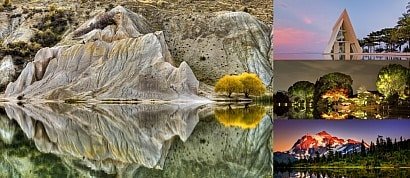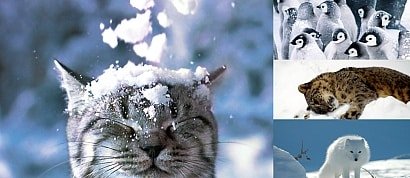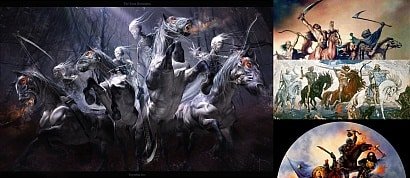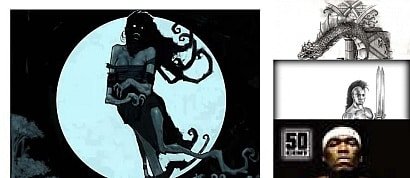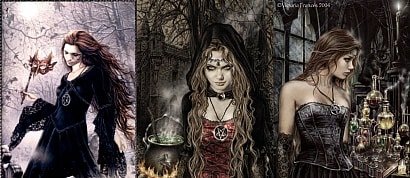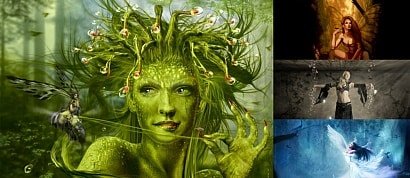The Titans,The Olympians and The Greek Heroes
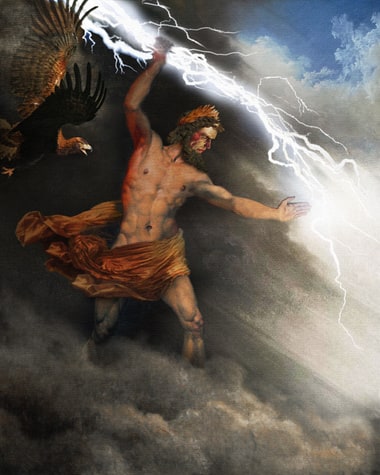
Zeus [aka Jupiter or Jove]
The very name, Zeus, from the Sanskrit root Dyaus and the Latin Dies evoke the luminous sky. He was the sky god and awarded himself the heavens upon defeating his father in the war with the Titans. Both the son of Cronus and his ultimate undoing, he would later become the king of the gods and master of Olympus. He was the brother or father of all of the Olympians. He was commonly known for his wrath and his constant infidelities against his sister and wife Hera, the Queen of Heaven, for he loved many goddesses and mortal women. He was commonly depicted in art from the Classical period - robed and enthroned, but in the tales of Greek mythology he was fast to wrath and usually shown as spiteful and petty hurling the master thunderbolt given him by the Cyclopes in the War with the Titans. In my painting I have chosen the Early Greek period shortly after the war.

Hades [aka Pluto]
One of the three sons of Titan King Cronus, he became the ruler of the nether realm. He was given the helmet of invisibility by the Cyclopes in the Titanomachy, the war between the Titans and the Olympians. After defeating Cronos he was given the underworld to rule, judging over the dead, he is usually depicted as a stern and hard man, it was said that no worship, sacrifice, or pleading could sway his mind once a decision had been made, but he was fair and just in his judgments. He is famous for being given a love potion and becoming enamoured with and kidnapping his wife, the spring goddess Persephone who is usually depicted by his side and it was in this setting that he was also known to the Greeks as Pluto “the giver of wealth”. After a time, his skin was said to have turned grey, but in this painting, I have shown him in the early days of his Subterranean Kingship. His symbols were the snake and Cerberus, the three-headed dog which guarded the Underworld.

Prometheus [no alias]
A Titan who was said to have created mankind with his own tears, he sided with the Olympians in the Titanomachy, the war between the Titans and the Olympians. Prometheus (who foresees) held a grudge against the Olympians for the destruction of his race. He is most commonly known for stealing fire from the gods and giving it to man,. He is commonly depicted as the protector of mankind often opposing Zeus when his wrath for the mortals would have him wipe them out. Because of Zeus’s anger over the meeting of gods and men at Mecone he took fire to the mortals, Zeus had planned to give it to them but his anger over his sacrifice made him withdraw the gift. Prometheus would for his theft be chained to a mountain cliff where an eagle [a symbol of Zeus] would come and eat his liver daily. feeling mankind also needed to be punished for this gift of fire, Zeus created and sent the first woman, Pandora.

Herakles [aka Hercules]
The most famous of Greek Heroes, he was son to Zeus and Alcmene, which provoked Hera to wrath sending serpents to kill the infant in his crib. Later in life Hera would strike again sending a madness that would force him to kill his wife and children, resulting in him serving the lord of Argos and performing twelve labors to earn his redemption. after his death he was burned and his divine half was said to ascend to the heavens where he married Hebe, and was reconciled with Hera. The 12 labors included the capture of the lion of Nemea; the Hydra of Lerna; the capture of the stag of Arcadia; the capture of the boar of Erymanthus; cleaning the stables of Augeias; shooting the birds of Stymphalus; capturing the Cretan bull; capture of the Mares of Diomedes in Thrace; taking the girdill of Hippolyte queen of the Amazons; sizing the cattle of Geryon; gathering the Apples of the Hesperides; fetching up the Cerberus from the nether world.

Hephaestus [aka Vulcan]
The son of Zeus and Hera, he was the god of fire and culture. Upon his birth he was cast out of the heavens because of his disability, only to be taken in by the water spirits and later returned. His main role was as that of the smith of the gods making most of their weapons, armor, and tools. He was the husband of Aphrodite and partner to Athena in spreading wisdom and culture.) The relation between Hephaestus and Prometheus is in some respects close, though the distinction between these gods is clearly marked. The fire as an element belongs to the Olympian Hephaestus. He is usually depicted pounding molten metal with a hammer but in this painting, I showcase his craftmanship, artistry and attention to detail.

Poseidon [aka Neptune]
Poseidon was, like Zeus and Hades, A son of Cronus, after helping to defeat his father he was given the oceans to rule as his domain. He was also known as the creator of the first horse as well as the bringer of earth quakes, which where usually the result of his anger during a argument over who controlled the land. He sided with Greeks during the war with troy because the Trojans cheated him after he built their wall. He had many children that were usually savage and cruel like the sea. In his depictions he is usually depicted similar to Zeus but with less majestic calm, he is usually shown with his trident, crafted for him by the Cyclopes which he used to control the seas. This painting is based on a French 18th century marble statue.

ARES [aka Mars]
The son of Zeus and Hera he was the god of war, and is often depicted as loving battle for the sake of battle. He was famous for randomly picking a side in a conflict regardless of the justice of one side or another. He would go to war either on foot or in his war-chariot which his two sons Deimos and Phobos (fear and panic) would make ready for him in the Odyssey. His fits of rage were legendary and Zeus despised him. He was the illicit lover of Aphrodite and was caught by her husband Hephaestus in the act, later being presented to the rest of the gods to be ridiculed.

Athena [aka Minerva]
The Daughter of Zeus and his wife Metis, Zeus swallowed his wife when she was pregnant with Athena because of a prophecy that their children might be more powerful then him and dethrone him, Prometheus because of this act split Zeus’ s head with a hatchet and Athena leapt out fully clad in shield and armor. She was the goddess of counsel, of war, of female arts and industries, and protectress of Greek city’s. She was commonly depicted with her helmet, the Agies, the round shield with the face of the gorgon on it , the lance, an olive branch, the owl, cock and the snack.

Apollon [aka Apollo]
The son of Zeus and Leto his mother was pursued by Hera to the floating rock Delos where he was born under a palm tree because of the when and where of his birth the full and new moon cycles where considered sacred to him. Homer depicted him as a god of prophecy, the sender of plagues, and the god of agriculture. Often referred to for his physical prowess he was said to be the first winner of the Olympic games. Upon his birth he slew the Python bringer of winter and darkness and was found guilty by the gods of murder he was then forced to wander the earth in penance.

Artemis [aka Diana]
The daughter of Zeus and Leto the twin sister to Apollo though said to have been born the day before and on a different part of the barren island. She is the goddess of the Moon and the hunt but also chastity and the protector of young men and ladies, this role often put her in conflict with Aphrodite and her brother as well. She was also known as a goddess that would deal death as well as a goddess of purifying and healing powers like her twin. She is often depicted as chasing her brother Apollo around the world through the sky in an endless chase between night and day.

Demeter [aka Ceres]
Her name evolved from a primitive form of the words "Earth Mother" Demeter appeared above all as goddess of the fruits and riches of the fields. Usually depicted seated and dressed in a long robe with a veil covering the back of her head. She was the corn goddess and wheat and barley were sacred to her. She presided over the harvest and all the agricultural labors that went into it. The eldest daughter of Cronus and sister to Zeus, she was the first devoured to avoid a prophecy of being overthrown by his children and last to be spit up after living with her siblings in his stomach. She was widely worshiped in the pre-historic and ancient worlds and was mother to Persephone, the goddess of Spring during the heyday of Classical Greece.

Hera [aka Juno]
Both the sister and wife of Zeus and Olympian Queen of Heaven, she was said to have severe beauty and was usually shown crowned with a diadem and wearing a long tunic with a veil. She had two primary roles in their religion; as the consort of Zeus and queen of heaven, and the goddess that presided over marriage,. She was also the birth-goddess, as well as goddess of flowers who presided over all phases of feminine existence. Hera was said to be modest, the representation of the ideal wife, but still stood out as the most physically beautiful of the Olympians. She is often shown as vengeful and jealous, even leaving Zeus for a time to punish his infidelity. Her sacred symbols were Peacocks with their spangled plumage and a Lotus staff.

Hermes [aka Mercury]
He was the Son of Zeus and Maia (a daughter of Atlas), in his earliest role he was the god of fertility, and generally associated with the protection of wild life. With the Iliad he was given the duty of herald of the Gods, as well as the conductor of the dead to Hades. His most common identifying depictions where his winged helmet, winged shoes and his Caduceus or herald’s staff.

Hestia [aka Vesta]
The Hearth-goddess and daughter of Cronus, she swore to remain a maiden forever after Apollo and Poseidon tried to when her hand. Zeus then bestowed her with the title of chiefly worship of the family Hearth. In later versions she would become the hearth-goddess of the universe and become the personification of earth as the center of the universe. She had no real part in the legends of the gods.

Aphrodite [aka Venus]
Aphrodite Urania, was the celestial goddess of pure and ideal love, Aphrodite Genetrix or Nymphia favored and protected marriage, Aphrodite Porne was the goddess of lust and venal love, the patroness of prostitutes. The daughter of Zeus and Dione, daughter of Oceanus she was married to Hephaestus but was also the lover of Aries, the god of war, and had a daughter with him named Harmonia. She was the goddess of all fruitfulness in the human, animal and vegetable worlds; she was depicted as influencing all living things in heaven, earth and the sea even having sway over her fellow gods. She is most commonly known as the goddess of love and beauty.
Mythology as I was taught, is the study of legendary religious or heroic events so alien to what we have seen and heard that we cannot accept them as reality. This explains the choice of the name, the English adjective "mythical" meaning "unbelievable". Of course, these stories were considered to be true at the time by the religiously minded.
The primary function of these stories was to answer difficult questions about who we are and how we came to be. Another value of myth was to validate social institutions and account for traditions, rites and customs. Primitive cultures often remodeled the older myths to adapt to changes wrought by revolution, war or technology, and usually glossed over the brutality and corrupt motives.
From the dawn of mankind story-telling has been a tool of record-keeping and the Greek civilization was no exception. Around 1100 BC we have records that the Greeks had in place an institutionalized form of story-telling about their gods, heroes, and mortals, almost always taught a moral lesson and always seemed to create a reflection of the heavenly realm in parallel events on Earth.
To properly study and even more so to illustrate myth, a large body of esoteric historical, anthropological, cultural, geographic, and architectural knowledge must be mastered; also knowledge of the properties of flora and fauna, and the appearance and habits of wild beasts and birds.
The Legends of the Greeks were broken into Three Ages; The myths of origin or the age of the gods, tales about the origins of the world, the gods, and mankind. The age when the gods and mortals interacted closely; legends of early conflicts and consorts between mortal men and women, demigods, and immortals. The age of heroes or the heroic age was a time when Olympian activity on Earth was far less common. The Iliad by Homer was the greatest of these heroic legends and carved in stone the details of Greek Mythology we know to this day, his account of the Trojan War and subsequent events is considered by some scholars to be yet a fourth period. There are myths for every race and culture, this exhibition contains illustrations of the myths of the Greeks and Romans....
The primary function of these stories was to answer difficult questions about who we are and how we came to be. Another value of myth was to validate social institutions and account for traditions, rites and customs. Primitive cultures often remodeled the older myths to adapt to changes wrought by revolution, war or technology, and usually glossed over the brutality and corrupt motives.
From the dawn of mankind story-telling has been a tool of record-keeping and the Greek civilization was no exception. Around 1100 BC we have records that the Greeks had in place an institutionalized form of story-telling about their gods, heroes, and mortals, almost always taught a moral lesson and always seemed to create a reflection of the heavenly realm in parallel events on Earth.
To properly study and even more so to illustrate myth, a large body of esoteric historical, anthropological, cultural, geographic, and architectural knowledge must be mastered; also knowledge of the properties of flora and fauna, and the appearance and habits of wild beasts and birds.
The Legends of the Greeks were broken into Three Ages; The myths of origin or the age of the gods, tales about the origins of the world, the gods, and mankind. The age when the gods and mortals interacted closely; legends of early conflicts and consorts between mortal men and women, demigods, and immortals. The age of heroes or the heroic age was a time when Olympian activity on Earth was far less common. The Iliad by Homer was the greatest of these heroic legends and carved in stone the details of Greek Mythology we know to this day, his account of the Trojan War and subsequent events is considered by some scholars to be yet a fourth period. There are myths for every race and culture, this exhibition contains illustrations of the myths of the Greeks and Romans....
Added to
People who voted for this also voted for
Mirror Lake
Ancient Alien
Winter
Christmas Medley
Eyegasm - 7
Fictional Places Actually Existed
Animal Humor, part 1
Wraiths
The Four Horsemen of the Apocalypse
Amazing landscapes and beautiful places
Classic Posters, Modern Message II
Villiana Movie Posters
Fantasy
Make me laugh, part I
Black Holes
More lists from Katherine Fell
Mythical Creatures
Art by Victoria Frances
Places
Mother Earth
Fairies:Pictures Made People Believe
The Nymphs
Top 10 Unusual Cemeteries
 Login
Login
